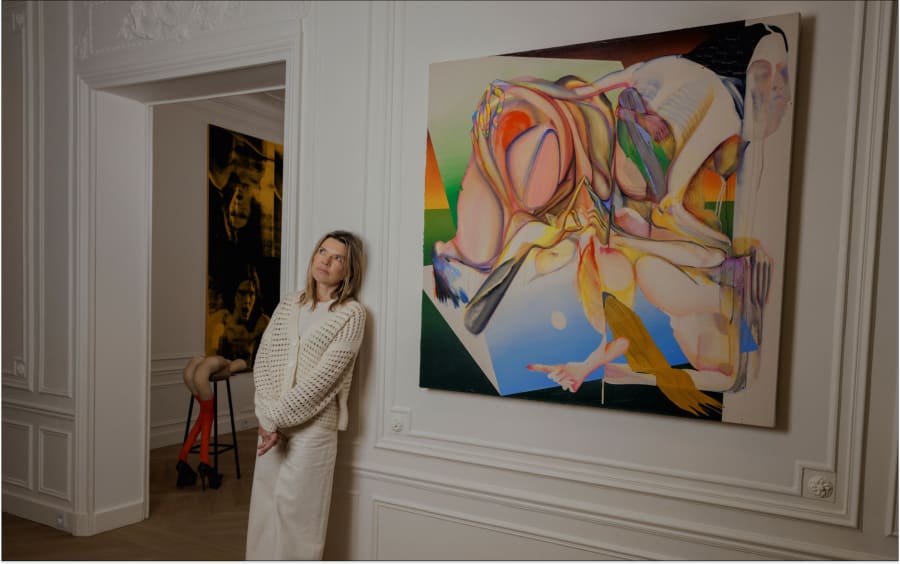‘My husband Hervé and I started to collect about 20 years ago. We began by gifting each other works, not with the intention of collecting, but perhaps to communicate in a different way, expressing ourselves through the artworks. Over time, this exchange grew into a substantial ensemble. This led us to take a step back and consider it as a collection, and to identify a common thread between the works.
‘This thread, although broad, was consistently radical: it revolved around human excess, whether individual (illness, trauma, self-destruction, revolt, etc.) or collective (oppression, violence, war, etc.). Our first acquisitions tackled these themes head-on, with powerful works such as the photographic series by Jeffrey Silverthorne and Andres Serrano, both shot in mortuaries. Today, our process has evolved, and we favor a more focused approach, since it is now a question of completing an already coherent whole.
‘Every work that enters our collection must be approved by both of us. We make all our decisions together, without committees or consultants. It’s been a fundamental principle of our acquisition process since the beginning. Each work we buy bears the mark of a shared moment, of exchanges and reflections between the two of us. That’s the whole point of our collection: it’s the fruit of an intimate dialogue. Our pleasure in acquiring a work is inextricably linked to the joy of discovery, the confrontation of ideas, and the discussions it provokes between us. What does it awaken in us? This question is central to our approach. Today, our collection includes almost 900 works by international artists. It is made up of about 40% photographs, 40% paintings and drawings, and 20% sculptures, installations, and a few videos, mainly of filmed performances.
‘We always wanted to share our work by hanging it in our home, but also in Hervé’s communications agency. It was already a way of conversing with those around us: family, friends, but also our clients. In 2009, we created the Fondation Francès, which was born out of our businesses: Okó, Hervé’s communications agency, and ARROI, my cultural engineering company. The aim was to structure our desire to share through a professional, completely independent tool, fed solely by our own resources and dedicated to the dissemination of our collection. We set up the center in Senlis, in the Oise region of Hauts-de-France, which at the time lacked a dynamic contemporary art scene. This choice of location enabled us to reach a wide public, who were sometimes confronted with works that might offend or surprise them. Faced with visitors who were unfamiliar with and often resistant to contemporary art, it was essential to support them in their discoveries with specially devised information. That is why, in 2013, I created “La Fabrique de l’Esprit®”, an educational program that has allowed us to create real dialogue around the works, fostering greater understanding and openness.
‘All the exhibitions I’ve organized for and at the foundation have involved a particular kind of exchange aimed at informing, but also respecting the distance between the viewer and the work. We regularly invited an artist from the collection to talk to the public about their work and about other works in the collection, but after five years, we decided to modify the program by inviting artists represented in our collection to have solo exhibitions. These showcased works from our collection but focused on collaborating with artists to provide a more intimate insight into their practice. The foundation, a detached stone house, reinforced this sense of intimacy and encouraged an emotional relationship with the works while offering greater proximity to the artists. We have worked with Gavin Turk, Erwin Olaf, and Claire Morgan.
‘Later, with Mircea Cantor in 2016, and then Kader Attia in 2019, we adopted a different format, organizing exhibitions that lasted a year or more. The aim was to give visitors time to engage with the shows while allowing the artists to benefit from a more expansive working environment that encouraged experimentation. In 2015, I created the organization “Françoise pour l’œuvre contemporaine”, dedicated to emerging artists, with the goal of offering them a free platform, an international residency program, and, during the health crisis, digital tools, open studios, and an online gallery. At the end of the pandemic, when the foundation was able to reopen, we responded to a new demand from artists, and on the first floor, we exhibited young graduates, organized first solo exhibitions, and explored new directions. A floor is still dedicated to the presentation of a selection of works from the collection. At the same time, in 2022, we opened our exhibitions to the public in Clichy, at the premises of Hervé’s agency, Okó. This three-story industrial building, with its open workspace, houses our thematic shows.
‘We are currently presenting “XXH”, which stands for “eXtra eXtra Humain”, an exhibition that explores individual and collective excesses. The title perfectly reflects the central themes of our collection and the exhibition, which marks the foundation’s 15th anniversary, brings together some of the major works acquired over the last 20 years, including Gloria Friedmann’s The Human Factor (2005). Above all, we are passionate about making our collection more than just a group of works: it is a living object, a constantly evolving space for exchange and reflection. A work of art can’t change the world, but it can change the way we look at it.’
English translation: Art Basel.
Florence Derieux is an art historian and curator.
Caption for header image: Installation view of the exhibition ‘XXH’ at the Fondation Francès, Clichy, 2024. Courtesy of Fondation Francès.
Published on December 10, 2024.


